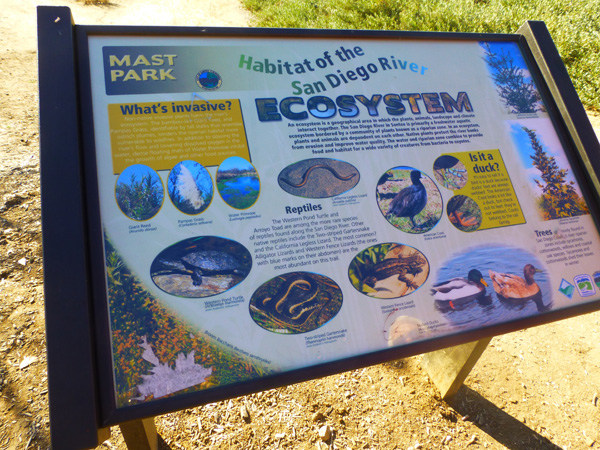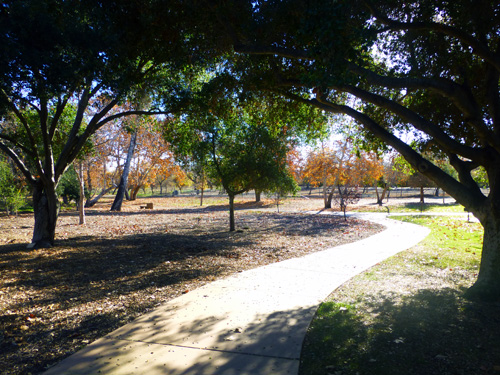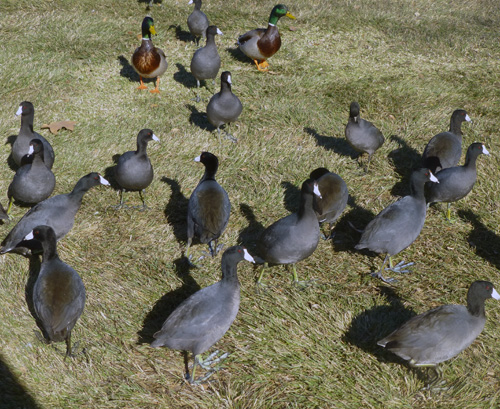
By Donald H. Harrison


SANTEE, California — The Hoosier Poet James Whitcomb Riley is credited with the saying, “When I see a bird that walks like a duck and swims like a duck and quacks like a duck, I call that bird a duck.” However, an informational sign board at Mast Park “rails” against such thinking. People may confuse the American coot with a duck, but unlike a duck, it doesn’t have webbed feet. So, it’s a rail, not a duck.
On the same sign, there’s educational information that should discourage us from saying “if its long and thin like a snake, and crawls on its belly like a snake, it’s a snake” because it just may be a California Legless Lizard, which differs from a snake in that it has external ears, eyelids that move and can detach its tail if it needs to get away in a hurry from its predators.
So, as I was walking on Monday, Dec. 30, with friend Bob Lauritzen around Mast Park, which is a tree-laden part of the San Diego River system, upstream from the Santee Lakes, this information got me to thinking. If we have to be careful in our generalizations about animals, and not lump them all together based on one quick, superficial view, how much more true is that about people?


We in the Jewish community find it odd and quite difficult to believe that some of our neighbors think that we Jews are all alike. Among ourselves, we are aware of so many differences. There are secular Jews and religious Jews, and among the latter, there are people who are Reform, Reconstructionist, Conservative and Orthodox. And among the Orthodox, there are those we call Chasidim, who follow the teachings of their rebbes, and the Mitnagdim, who focus on Torah learning and study. Among these classifications of Jews, there are many sub-classifications. And then there are those whose ancestors settled in Central and Eastern Europe (the Ashkenazim) and those who were expelled from Spain and Portugal and settled in various parts of the Middle East and the Americas (the Sephardim).
Some of our fellow Jews are Zionists and some are anti-Zionists. Some believe the Bible is the literal word of God; others believe it was written by wise men, inspired by God. Still others believe that God had nothing to do with the writing of the Bible. And don’t even get me started on politics. If you want to see differences of political opinion, visit Israel’s Knesset. Or tune into some of the debates here in the U.S. between the National Jewish Democratic Council and the Republican Jewish Coalition.
Yet, while we appreciate the differences among ourselves, how many in our Jewish community are just as guilty of over-generalization when we think about Muslims? As silly as we think it may be to generalize about Jews, don’t we have a tendency to lump all Muslims together? Whether they are Sunni, or Shi’ite, do we imagine them all to be our adversaries, just because they are Muslim? Whether they speak Arabic, Turkish, Kurdish, Russian, Malay, an Indonesian, or African dialect, do we categorize them all as woven from the same spiritual cloth, having the same aspirations and same hatreds?
And what about Arabs? Do we forget that they are named for the language that they speak and there are Muslim Arabs, Christian Arabs, and yes, though it may seem a contradiction in terms, even Jewish Arabs? I remember meeting Andre Azoulay one year during a visit to the Peres Peace Center in Israel. He is a member of the Jewish community of Morocco, and a trusted advisor to that country’s royal family. “Jewish Arab” is the way he identifies himself.
Leapin’ Lizards, as the cartoon character Annie used to say–or maybe I should modify that to “Legless Lizards!” –what am I driving at here? With no disrespect intended to the memory of the poet James Whitcomb Riley, I think we have to conclude that how someone looks, or speaks, or walks, simply isn’t sufficient for us to make a judgment. There are many other factors to take into consideration, whether we are dealing with animals or our fellow humans.
*
Harrison is editor of San Diego Jewish World. He may be contacted via donald.harrison@sdjewishworld.com